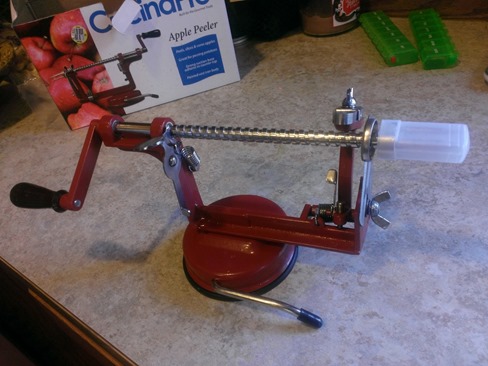Recent Articles
Making homemade applesauce
10.6 years ago apples, applesauce, recipe Leave a comment
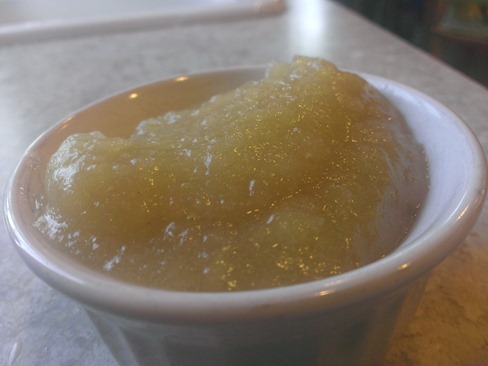
This weekend we decided to head to our favorite pumpkin patch to get some obvious pumpkins, kettle corn, cider donuts, and about a dozen pounds of u-pick apples.
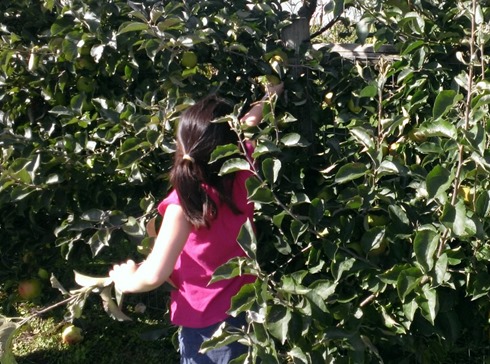
Now that I have amassed a plethora of apples we decided to make some homemade applesauce. For just a few apples I would just cut the apples by hand but with this many I break out my apple peeler which gets the assembly line moving much faster.
If interested here is the applesauce recipe I traditionally use for my applesauce…not super sweet but with nice hint of lemon.
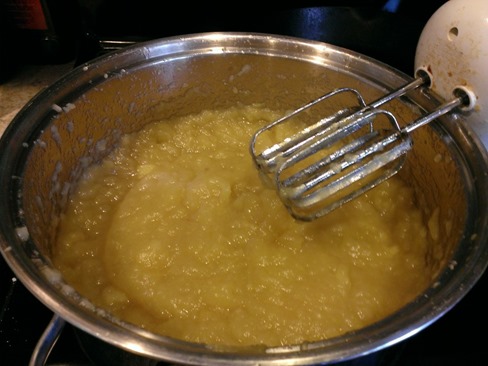
- 5-6 pounds of apples (peeled, cored, quartered)
- peel of half a lemon
- Juice of two lemons
- ½ teaspoon cinnamon (more if desired)
- ½ cup white sugar
- ½ cup brown sugar
- 1.5 cup water
- 1 teaspoon of salt
- Add all ingredients into large pot over medium high heat. Cover and bring to boil then lower temperature to low and simmer for at least 30 minutes. Note: This also works great with a crockpot (high to boil and low for 30+ minutes)
- Once the apples get a soft and mushy remove lemon peels and mash with a potato masher. For a less physical approach an egg beater (personal favorite), immersion blender, food processor, or blender (pulsing) can smooth things out real quickly
Good for on year in the freezer and probably good for a couple weeks in the refrigerator…though it has never lasted that long with my 11 year old daughter knowing about it. Great cold but I like it best warm with a bit of vanilla ice cream or a splash of cream or whipping cream.
Growing Your Own Kale in the Garden
10.6 years ago kale, winter garden 1 Comment

Kale is a vegetable that is up and coming in American society, both in restaurants and in the home kitchen. My favorite way to prepare it involves flash grilling over my fire pit and a homemade Caesar dressing, but the options are limitless.
Many people think that Kale is best grown in cooler areas, and while this is sometimes true, it is in fact a crop that can grow across a wide range of locations in virtually all seasons. Whether you’re planting from seeds or pre-grown starts, this veggie isn’t hard to grow and provides plenty of nutrition to make the process worth your time.
While you as the grower can decide how technical you want to get when growing kale, there are some basics below in case you’ve never grown anything similar. While the duration of seed to harvest will be determined by a number of factors, here are some tips to get you from start to finish.
1. Preparing the right soil
Kale grows best in moist but not damp soil, with mid-level pH and not too firm structure. The plant likes the ability to have space within the ground, but not too much. This veggie will grow in a plethora of soil conditions, but can become increasingly bitter if placed in compromising conditions.
Take home: Find a good soil and keep it moist. If it’s too acidic, add some wood ash or some other natural substance to neutralize it. You’ll be good to go!
2. Determine ideal positioning in garden by season
While kale can grow across seasons, it’s beneficial for you to consider the position of your planting with relation to the weather. If it’s the middle of summer, find a spot where a certain amount of shade will be offered on a given day. If it’s fall, aim for a spot that will receive constant sunlight. Balance is key for kale!
Take home: Kale grows much more efficiently and becomes more delicious with proper positioning. While avoiding over analyzing the situation, use good judgment and plant it where you think it has the best chance at growth.
3. Focus on keeping the soil moist
Kale really flourishes with moist soil, and it’s imperative that you keep it satisfied. If not, the leaves can become brittle and bitter to the taste. When then plant is just under a foot high, you can begin cutting the leaves off, but be sure to maintain watering all the way through the journey.
Take home: Most plants thrive with moisture. Kale is no different. While this vegetable can and will grow in a variety of situations with a wide range of unique methods, for optimum results, moisture is your ticket to sweet kale.
Regardless of whether you’re aiming to make bulk amounts of kale Caesar salad like me, or simply want to grow a nice veggie for your early fall family reunion, kale is a forgiving plant that will be sure to please the crowds.
Mackenzie Kupfer is a writer and gardener. She’s been growing tasty treats like kale in her yard for many years and likes to spread the wealth of her ventures by sharing wisdom online and veggie dishes at home.
Tips for Getting Started with Year-Round Gardening
10.6 years ago raised garden, winter garden Leave a comment
As many of us grow more environmentally conscious and feel an increased concern about exposure to chemicals and toxins, one appealing option for wrestling back control over what goes into our systems is to grow our own fruits and vegetables. However, the steps involved in planting, maintaining, and harvesting a successful crop can feel daunting, especially to those of us who have had trouble keeping household plants alive in the past.
The key to overcoming this anxiety is simple: by employing a few simple techniques, planning ahead and creating a manageable chart of necessary activities, it will be easy to keep your garden blooming year-round.
Step One: Decide What to Plant and When
Because you’re going to be a year-round gardener, any time is a good time to figure out which plants to grow in the coming season. Which ones you choose will be dependent to a large extent on where you live. Different vegetables thrive at different times of year and in different climates. Consult your local gardening organization or gardening center for advice concerning which crops are most advisable for your particular location.
Certain hardy crops can be planted as early as February, while warm season crops should generally go into the ground after the last average frost date. By late summer, you can plant crops for your fall garden – these should go in at least two months before you expect the earliest fall frost. Certain crops like garlic and onions can be planted as late as October! The key is to keep planting throughout the year, so that you can also harvest vegetables year-round.
Step Two: Create a Gardening Chart
Create a gardening calendar with sections for each month of the year. Here is an example of a basic planting guide that was prepared for gardeners in Central Arkansas: http://www.uaex.edu/Other_Areas/publications/PDF/FSA-6062.pdf. Another example focuses less on which vegetables to plant in which month and much more on the activities that are needed to maintain a garden: http://www.humeseeds.com/projndx.htm.
A different option is to create a chart with rows for each month and columns for different types of things to do in the garden. For example, you could have a column for planting, another for maintenance activities, and one for harvesting. This means that for April, you could look at column one to see which plants to put in the ground, column two to see how often to water or fertilize them, and column three to check on which plants should be ready to be harvested.
Step Three: Use Techniques That Enable You to Extend the Growing Season
There are many methods of extending the growing season of your garden. Three basic ones that will be discussed here are:
- Raised bed gardening
- Planting seeds indoors
- Plastic-covered tunnels
Other options you might wish to explore include cloches, cold frames, underground greenhouses, and solar-charged hot water bottles.
To begin with, raised bed gardening offers several advantages. In particular, raised beds allow you to extend the gardening season because the soil will warm up earlier, meaning you can start growing crops sooner. Additionally, because the beds are raised off the ground, it is not as difficult to work on the garden in rainy weather. This type of garden also typically offers higher yields and better soil.
Raised bed gardens even require less water and generally contain fewer weeds. You can purchase or build raised beds, or even create them by shaping rectangular mounds of soil a few inches above the ground level so that they are wide enough to reach across. However, make sure to use sufficient mulch to keep the soil in place if it rains heavily.
Next, planting seeds indoors allows you to multiply the number of planting seasons available to you. Instead of winter, spring, summer, and fall, you will have early spring, mid-spring, late spring, summer, early fall, late fall, and winter. By starting the plants inside and only moving them to the garden when other plants are harvested, you can make use of more limited space. The key is having a firm plan for garden layout and crop rotation.
Finally, this technique can be supplemented by using plastic-covered tunnels for mini-greenhouses. Not only will this allow you to plant earlier in the spring, it also provides a place to harden the tender seedlings you have been growing indoors while you are waiting for space to open up in the garden. You can use fence wire to support the tunnels; another option is to use hoops cut from wood, wire, or pipe. In addition, cover the tunnels with blankets or tablecloths when it is especially cold and cut V-shaped vents in the sides in order to improve ventilation.
What vegetables would you like to grow in your garden? Have you had success with year-round gardening in the past?
Since 2000, Chris Long has been a store associate at a Home Depot in Illinois. He also contributes to the Home Depot blog, and provides raised bed garden advice as well as tips on other home landscaping topics.
No room for a garden at home? Start one on top of a bus
10.6 years ago Uncategorized 1 Comment

Interesting approach to get gardens in some very interesting places. The system uses the waste from the air conditioning to water the plants and can provide some much needed photosynthesis in very congested areas in the world scrubbing air as they go. So sure you prized tomatoes would not survive going 50 MPH down the freeway but a very interesting approach to make use of some otherwise dead space.
Via Gizmodo
How to make pickles
10.7 years ago cucumbers, pickles, recipe 4 Comments
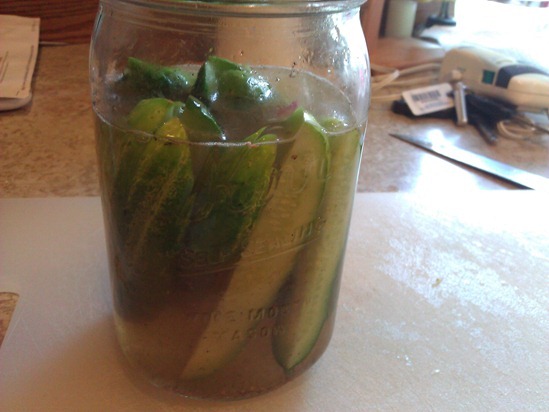 When my first cucumber started to rot in the vine when I was waiting for it to mature, I realized that I grew the smaller variety of which grows 6-8 inch cucumbers which are perfect for pickling to enjoy a nice nutritional snack. Having a few nice specimens on the vine this afternoon I decided to make myself a few pickles. Step 1: Clean the pickles. One of the surprises when I picked my first cucumber a few years back was the little spikes they have on them…you don’t see any of those by the time they make it to you in the grocery store. I quick bit of brushing of your hand should get these off. Finish this off with a quick wash in the sink and you should have a few clean almost pickles.
When my first cucumber started to rot in the vine when I was waiting for it to mature, I realized that I grew the smaller variety of which grows 6-8 inch cucumbers which are perfect for pickling to enjoy a nice nutritional snack. Having a few nice specimens on the vine this afternoon I decided to make myself a few pickles. Step 1: Clean the pickles. One of the surprises when I picked my first cucumber a few years back was the little spikes they have on them…you don’t see any of those by the time they make it to you in the grocery store. I quick bit of brushing of your hand should get these off. Finish this off with a quick wash in the sink and you should have a few clean almost pickles. 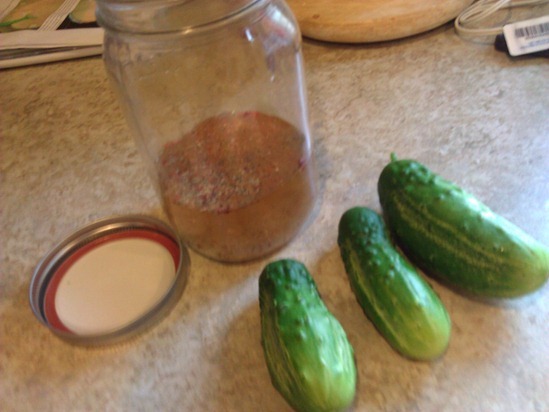 Step 2: Cut the Pickles. If you have a small variety like mine you can get away with simply quartering (or cutting in sixths if you have an extra girthy one). For full size cucumbers you will probably need to cut it into two pieces and cut each half into sixths or eighths depending on how large of spears you desire.
Step 2: Cut the Pickles. If you have a small variety like mine you can get away with simply quartering (or cutting in sixths if you have an extra girthy one). For full size cucumbers you will probably need to cut it into two pieces and cut each half into sixths or eighths depending on how large of spears you desire. 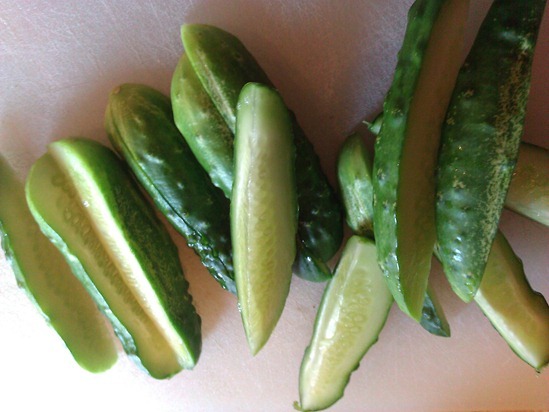 Step 3: Brine the Pickles. There are many good recipes for brines out there. Here is my favorite that provides a good balance of sweet/salty/spicy as well as some extra components to have a nice balanced flavor profile. Simply add the ingredients to a 1 quart mason jar, give it a little shake, then add your cucumbers. Secure the lid of the jar and give the jar another shake and place in your refrigerator.
Step 3: Brine the Pickles. There are many good recipes for brines out there. Here is my favorite that provides a good balance of sweet/salty/spicy as well as some extra components to have a nice balanced flavor profile. Simply add the ingredients to a 1 quart mason jar, give it a little shake, then add your cucumbers. Secure the lid of the jar and give the jar another shake and place in your refrigerator.
My Pickle Brine
- 1 clove garlic
- 1/2 cup apple cider vinegar
- 1 cup water (or enough to cover the pickles)
- 3 T sugar (artificial sweetener works here)
- 1/2 tsp salt
- 1/2 tsp dill
- 1/4 tsp pepper flakes
- 1/4 tsp cloves
- 1/8 tsp cinnamon
- 1/4 tsp coriander
- 1/4 tsp mustard seed
- 1/4 tsp black pepper
Step 4: Wait. This can be the hardest part, you need to wait at least 3 days for your pickles to brine, possible a couple of days more if you needed to add much more than 1 cup of water to cover your cucumbers. As more cucumbers come in you can simply add them to the jar and have a non-stop supply of incoming snacks…at least until the end of summer. For something a little more traditional you can also try the following:
Alton Brown’s Dill Pickle Brine
- 5 1/2 ounces pickling salt, approximately 1/2 cup
- 1 gallon filtered water
- 3 pounds pickling cucumbers, 4 to 6-inches long
- 1 tablespoon black peppercorns
- 1 tablespoon red pepper flakes
- 2 cloves garlic, crushed
- 1 teaspoon dill seed
- 1 large bunch dill
Directions: Same process as above though probably going to have to wait 6-7 days before your pickles are ready and are good for about 2 months.
How to make a solar food dehydrator
10.7 years ago Uncategorized Leave a comment

If you’re growing your own fruit and vegetables, or just trying to eat the things that are produced locally, you come across one obvious problem: when something’s in season, you have more than you can handle, and then there’s nothing for the rest of the year. So the obvious solution is to preserve your food when you have it in abundance. Dehydration is an excellent preservation technique that’s easy to do and that maintains a lot more of the original nutrients than canning or freezing.
Wanting to get the benefits of dehydrating excess fruits but without the expense of purchasing nor the costs of electricity of powering the thing. The author had the great idea of building a solar powered dehydrator. Check the link for full build instructions…
Via Instructables via HackADay
